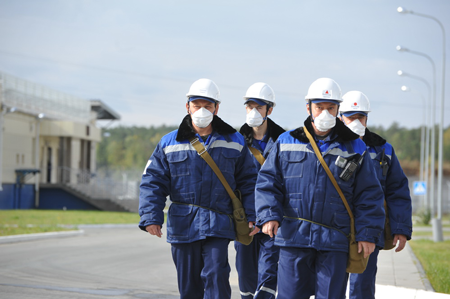The top-notch BN-800 power block of the Beloyarsk NPP is undergoing its first comprehensive exercise with over 20 foreign observers involved

At the moment, the prototype of the “power block of the future”, the BN-800 block running on fast neutrons, is getting ready for commissioning later this year, and this kind of exercise is the first one it faces.
Andrey Dementiev, the exercise manager, the deputy CEO and the director of Rosenergoatom Concern’s NPP production and operation department, said: “The Beloyarsk NPP is a unique plant, which is the only one in Russia to run a fast-neutrons’ reactor with primary sodium. This year, we are launching the newest power block No. 4, which is now being prepared for operational launch. The Beloyarsk NPP is on the edge of technical development. No other country boasts such track record in fast reactors; besides, the Russian NPPs’ emergency response system is second to none in the whole world”.
He also noted that the latter was the reason why over 20 foreign observers from 7 countries – France, Germany, South Korea, Finland, Norway, Sweden, and Belarus – paid a visit to the emergency response exercise this year.
Around 1200 Russian specialists took part in the exercise, including the representatives of the Rosenergoatom’s Crisis Center, the NPPEA group, the Rosatom’s Emergency Center, the Defense Ministry’s NBC protection troops, the departments of the Ministry of Civil Defence and Emergency Response, the Federal Bio-Medical Agency, and the Ministry of Internal affairs, along with the local authorities’ representatives and special agencies of the Sverdlovsk Region and the Zarechnyy city. 70 units of special equipment were utilized during the exercises. Besides, an air drone was used for the first time in the history of such exercises in order to carry out radiation intelligence in the Beloyarsk NPP’s sanitary protection zone.
According to one of the French observers, Didier Kemmel, the Director of the Security, quality, and environment protection administration at the Nuclear power commissariat, such exercises are a great opportunity for Russia to share its experience in emergency response. He stressed that the Russian NPPs boasts the highest possible level of nuclear and operational safety.
“The Russian experts are extremely hands-on and tech-savvy, while their equipment is unmatched”, Mr. Kemmel added.
It is important to note that the exercise scenario was based on the almost impossible combination of several unfavorable circumstances – natural disasters, power blocks’ system failure, etc. So, on the first day of the exercise, the participants mastered the actions of the Rosenergoatom Concern’s Crisis Center (Moscow) and the counter-emergency services at the Beloyarsk NPP’s site under a 7-points’ earthquake, which is unprecedented in this location.
Andrey Dementiev was positive about the outcomes of the first stage of the exercise. “The final evaluation of the exercise is due upon its completion at the Beloyarsk NPP”, he added.
The exercise is to last for two days, coming to an end on September 22, 2016. Apart from the Beloyarsk NPP, it will also cover the Zarechnyy urban district. During the second day of training, the team will master the cooperation between the medical and the fire brigades, as well as the radiation, chemical, biological protection and the civil protection team.

* The complex emergency response exercise is a major training taking place annually at one of the Russian NPPs (the Rosenergoatom Concern’s affiliate companies). The goal of the exercise is to verify emergency preparedness and to practices cooperation between special brigades, troops, and teams of different ministries and agencies aimed at emergency response and civil protection. Many countries hosting nuclear power plants carry out such exercises; however, the Russian one boasts special cooperation scale and a great number of bodies involved. The previous complex emergency response exercise was held at the Beloyarsk NPP in 2004.
The Beloyarsk NPP has come into operation in April 1964. The first power blocks of the Beloyarsk NPP with thermal reactors AMB-100 and AMB-200 has been closed after the accumulated running time. The power block with a fast industrial capacity reactor BN-600 is still on. The power block with a fact reactor BN-800Н is currently being prepared for coming into operation.
The up-to-date information on the nuclear environment close to the Russian NOOs and other nuclear objects is available at www.russianatom.ru
Information and Public Relations Administration Rosenergoatom Concern JSC.
The Information and PR Department of the Beloyarsk NPP.

 career
career Innovations
Innovations Projects
Projects INTERNATIONAL BUSINESS
INTERNATIONAL BUSINESS